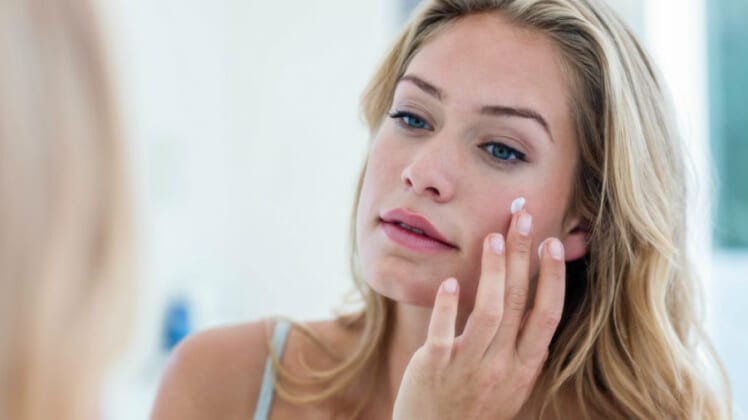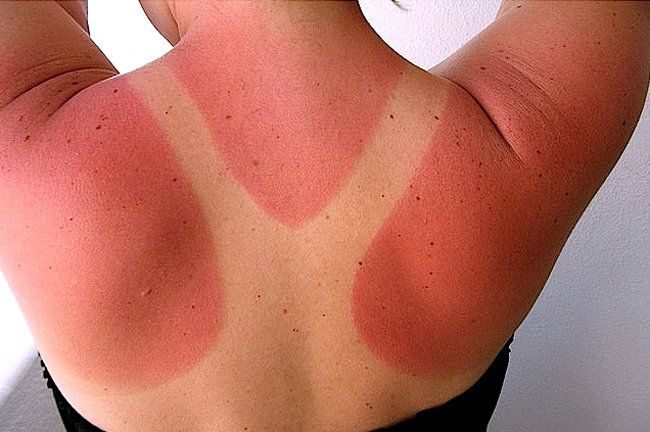12 Skin Conditions You Should Never Treat at Home

Our skin is the largest organ in our body, and it just so happens to be an external one, which means we can see pretty much everything that’s going on. It also contains more than 1,000 nerve endings that sense touch, pain, temperature, and pressure. So, when we get a burn, rash, scrape, or breakout, it can be tempting to self-treat whatever skin conditions are ailing us.
The good news is that the skin is pretty spectacular at healing itself. In fact, the superficial layers of our skin are in a constant state of renewal, with new cells replacing old ones about every four weeks, explains Loretta Ciraldo, MD, Miami-based dermatologist and founder of Dr. Loretta Skincare. “Skin will heal quickly and without scarring, if an injury is superficial,” she says. “However, if we injure the deeper layers of skin, the dermis, and subcutaneous tissue, we will heal with scarring.”
Luckily, the majority of skin conditions can be treated at home — either with natural remedies or over-the-counter products that can aid the skin back to good health. Sometimes, however, a skin concern requires treatment by a board-certified dermatologist. Because it can be hard to know when to seek help, we reached out to some of the nation’s top dermatologists to find out which skin care emergencies you can treat at home and which require the care of a professional.
Also Read: The Dangerous TikTok Skincare Trends Dermatologists Don’t Want You To Try
1. A mild sunburn
Direction: Treat at Home
For mild sunburns, Tiffany Libby, MD, a Rhode Island-based dermatologist, recommends first getting out of the sun as soon as possible so as to not exacerbate the burn. Then, use a cool compress or take a cool shower before applying calming, non-irritating, breathable gels, lotions, or creams to your skin. Additionally, she recommends staying hydrated, and taking NSAIDs, like Advil to minimize inflammation and reduce pain.
“Do not use topical analgesics like lidocaine or benzocaine sprays, as these may irritate the skin or cause an allergic reaction,” she says. “If the sunburn is severe — i.e. covers a large portion of the body, and involves extensive blistering — consult your dermatologist or seek immediate medical attention.” If you’re experiencing a slew of other unpleasant side effects alongside this skin condition, like fever, headache, severe pain, or chills, you should also seek immediate medical attention.
2. Blisters
Direction: Treat at Home
Whether it’s from friction caused by a poorly-fitting shoe or a first-degree burn, blisters are one of the most common skin conditions. The itching and oozy kind can be treated with warm compresses once dried and corticosteroid cream to reduce the inflammation, says Heidi A. Waldorf, MD, a dermatologist with Waldorf Dermatology Aesthetics in Nanuet, New York. The caveat: “If the blister affects a large area, causes swelling around the eyes or impedes daily activities, then you need to see your dermatologist for prescription treatment,” she adds.
Also Read: The Best Drugstore Skincare Buys According To Dermatologists
3. A blistering rash
Direction: See a Doctor
To the point above, a blistering rash, also known as Stevens-Johnson Syndrome, can sometimes be a sign of an allergy to a medication or a hypersensitivity reaction, explains Marisa Garshick, MD, a dermatologist at Medical Dermatology & Cosmetic Surgery (MDCS) in New York. “While it is especially important to stop the medication or the possible trigger, it is also important to contact your doctor right away to ensure appropriate treatment as soon as possible,” she says. “In some cases, this rash can lead to extensive skin peeling, which can increase the chance of infection.”
4. Hives

Direction: See a Doctor
Hives may seem like one of the fairly normal skin conditions on this list, but they are still considered a type 1 allergic reaction, says Dr. Garshick. “It is important to ensure that the allergy is only limited to the skin and not associated with difficulty breathing or swallowing,” she says. “While some of the treatments may be accessible to someone at home in the form of antihistamines, it is always important to contact your doctor to determine if any other treatment is needed.” For severe hives, your doctor may need to prescribe a short course of an oral corticosteroid drug to reduce inflammation and ease symptoms.
5. Acne breakouts
Direction: Treat at Home
It’s safe to say the majority of us have had a bad bout of acne here or there or a nasty pimple pop-up overnight. While it can feel like a skincare emergency, especially before a big event, breakouts can easily be treated at home using spot treatments with ingredients like benzoyl peroxide or salicylic acid, or popular pimple patches, says Dr. Garshick.
“It’s important to avoid picking, popping, or squeezing, no matter how desperate you may be,” she adds. “If it still doesn’t go away it is best to contact your board-certified dermatologist regarding additional treatment options.” In-office cortisone injections can help reduce the redness, swelling, and pain of stubborn inflammatory acne.
Also Read: 9 Best Olive Oil Skincare Products For Smooth Supple Skin
6. A cyst that won’t go away
Direction: See a Doctor
If you have a cyst or another liquid-filled lump that’s oozing or leaks out pus, seek the care of a board-certified dermatologist. “This can evolve into a deep-seated infection that can get into your bloodstream and cause [a range of serious complications, including blood poisoning],” warns Dr. Ciraldo. “The doctor will almost always drain the area and may place sterile packing inside and may even place you on antibiotics.”
7. Eczema flares
Direction: Treat at Home
“Atopic dermatitis (often called eczema) is the most common chronic inflammatory skin disease and is characterized by skin barrier disruption. This skin barrier disruption leads to dry skin, but eczema is more than just dry skin,” says Dr. Hadley King, MD, a board-certified dermatologist in New York City. Eczema is chronic and tends to flare periodically, with symptoms like red, itchy, chapped skin, and then subside.
There are a number of home remedies and OTC products that can help soothe flares. Dr. King recommends LomaLux’s all-natural Eczema Pills, a one-a-day, steroid-free pill formulated with five minerals shown to ease symptoms. Topically, look for thicker moisturizing creams with humectants like hyaluronic acid, skin-barrier-protecting ingredients like ceramides and petrolatum, and soothing ingredients like colloidal oatmeal and camphor.
8. A full-body breakout
Direction: See a Doctor
If you break out in sudden blotches or welts that spread quickly all over your body, call your doctor stat. This is one of the skin conditions that could be a sign of something more concerning, such as an allergic reaction, infection or an immune system disorder. Your doctor will be able to help you determine the cause of the rash and prescribe the proper treatment. If the rash is accompanied by a fever or pain, you should go to the emergency room so that it can quickly be evaluated by a physician.
Also Read: The Best Skincare Routine In Your 30s And Up
9. Post-filler complications
Direction: See a Doctor
Although rare, severe filler complications like arterial occlusion, which means that filler has been injected into an artery, can happen and put you at risk of necrosis or death of the tissue or even blindness. “Early signs of severe pain at the time of injection, whitening or blanching of the tissue, or bluish or net-like discoloration of tissue after a filler injection are signs to look for,” says Dr. Libby. “Contact your dermatologist immediately, as early evaluation and recognition of arterial occlusion will give you the best chance of fixing it and reversing side effects.”
10. A shallow cut
Direction: Treat at Home
While certain cuts could require a visit to your doctor, especially when deep or there’s the possibility of needing stitches, in most cases, they can be taken care of at home, providing there is no concern for infection, notes Dr. Garshick. “Typically, it is best to wash a cut with soap and water and subsequently apply a petroleum jelly ointment, such as Vaseline, and cover with a bandage to help facilitate healing,” she says. “The bandage can be changed daily, but the key is keeping the cut or the wound moisturized as this can help with healing.” If it is still not healing or if any redness, pus, or tenderness develops, she recommends making an appointment with your doctor.
11. Kitchen burns
Direction: Treat at Home
Kitchen burns happen to most at-home chefs, and luckily, they can be taken care heal fairly quickly. A first-degree burn — AKA a burn that only affects the outer layer of your skin — can be treated at home by running cool water over it to reduce the temperature, explains Dr. Ciraldo. She also recommends applying a medicated cream like silver sulfadiazine or a bland ointment like Vaseline or Biafine. An extensive or deeper burn, however, should always be checked out by a physician.
Also Read: Everything You’ve Ever Wanted To Know About Peptides In Skincare
12. A non-healing wound
Direction: See a Doctor
As a skin cancer surgeon, Dr. Libby has seen many patients who had what they thought was a non-healing wound or pimple that turned out to be skin cancer. “These are common presentations for skin cancer, and it is best to be evaluated by your dermatologist for early diagnosis and treatment,” she says. Bottom line: If you see something new on your skin that doesn’t go away within two weeks, make an appointment with your dermatologist stat.
Explore More About:Home & Garden


